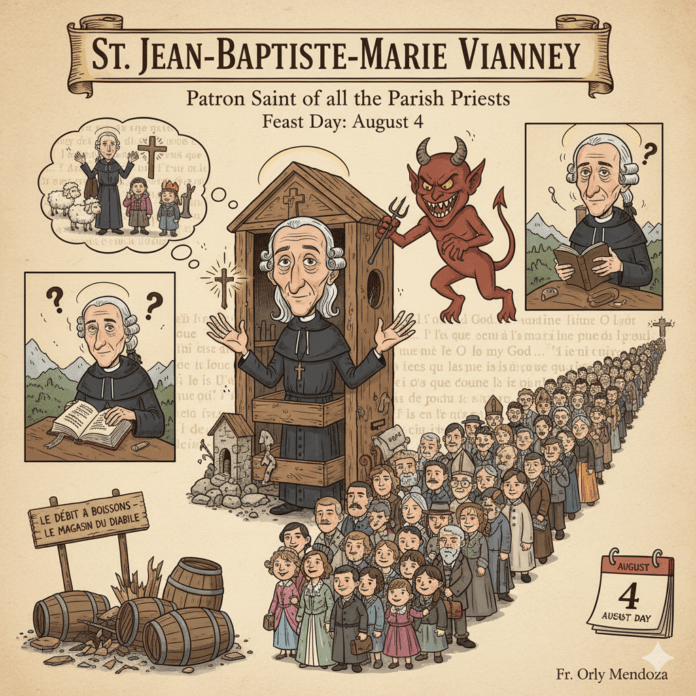St. Jean-Baptiste-Marie Vianney, also known as St. John Vianney, was born on May 8, 1786, as the third of six children, in Dardilly, near Lyons, France. He was baptized on the same day. His father, Matthieu Vianney, a farmer, and his mother, Marie Beluze, a humble housewife, were both devoted Catholics who raised their family in a traditional Catholic way. Although poor, they helped those in need and even offered hospitality to St. Benedict Joseph Labre, the Patron Saint of Tramps, who passed through Dardilly on his pilgrimage to Rome.
His mother taught him catechism when he was just a child. Although he struggled with other subjects, his family noticed that St. John Vianney was more skilled in spiritual matters than in other sciences. As a child, he was a shepherd, and while tending his flock, he often gathered the other young shepherds and taught them the catechism he learned from his mother. Due to the Revolution in France’s educational system, St. John was unable to receive a formal education. He learned to read and write from his older sister. As a prayerful young man, he realized that he could save more souls if he entered the seminary and became a priest.
So, he decided to pursue seminary training. He was already nineteen when his father allowed him to be tutored by M. Balley, the Curé of Ecully, who trained young boys aspiring to become priests. His classmates were boys aged eleven or twelve who learned the teachings with ease. Because of his limited early schooling, St. John struggled with Latin, the official language of the Church and its teachings. If it weren’t for his strong desire to become a priest and Balley’s patience, he might have given up before continuing.
In 1809, his priestly formation was interrupted by the forced recruitment of Napoleon’s Army. When he was to leave together with the recruits for Spain, he passed by a chapel and prayed. When he finished, his companions had already left. He tried to follow them but could not make it since he was a little bit ill at that time. A soldier encountered him and brought him to a hidden quarter of the deserters in the Mountains of Le Forez, in a Communal Village, called Les Noes. There he stayed for a year and two months under the care of Claudine Fayot, a widow with four children. He assumed the name of Jerome Vincent and taught catechesis to the children in the village. In 1810, an imperial decree was passed, pardoning all the deserters and allowing them to go back to their homes.
St. John continued his priestly training, and on May 28, 1811, he received the Tonsure. M. Balley, believing it necessary for his pupil to complete a proper course of studies, sent him to the Petit Seminaire of Verrieres. There, young Vianney endured much hardship and hard work but never excelled as a philosopher. In October 1813, he entered the Grand Seminaire of Lyons. After some struggles within the seminary and with the constant aid and moral support of M. Balley, St. John was finally ordained to the priesthood on August 13, 1815. He was assigned as an assistant pastor to his teacher and noble friend, M. Balley.
When his friend died, he was appointed as the pastor of the small parish of Ars, a remote town near Lyons. As a parish priest, he saw how deeply the French Revolution had wounded individuals and society as a whole, confirming this in his parish, which he described as a place where all kinds of sins were found. He worked hard throughout his entire ministry there to bring about the conversion of the people, starting with restoring Sunday as a holy day of obligation for all Christians and dismantling places of vice like taverns or bars, which he called “the devil’s shop, the market where souls are bartered, where the harmony of families is broken, and where quarrels and murders happen.” He founded an orphanage for destitute girls called “The Providence,” which he directed and where he taught catechism to the girls. Although it was successful, he closed it because many people opposed its existence.
The Holy Curé of Ars, as St. John was known, was renowned for his love of mortification and the Sacrament of Confession. He practiced severe mortification, eating and sleeping less than his body needed to survive. He spent between sixteen and eighteen hours daily in the confessional, especially during his last ten years of ministry. People from all walks of life—including some religious brothers and sisters, priests, and bishops—flocked to his church just to seek his advice and receive forgiveness through Confession. He was constantly troubled by demons but successfully fought them through prayer and mortification. He died on August 4, 1859, at the age of seventy-three.
On October 3, 1874, Blessed Pius IX proclaimed him Venerable; on January 8, 1905, Saint Pius X declared him Blessed and recommended him as a model for the parochial clergy; in 1925, Pope Pius XI canonized him. On March 16, 2009, Pope Benedict XVI proclaimed the year from June 19, 2009—June 19, 2010—as the “Year for Priests” to mark the 150th anniversary of the birth of the Curé of Ars. He also proclaimed St. John Mary Vianney as the Patron of parish priests worldwide.
THE PRAYER OF ST. JOHN MARY VIANNEY
I love You, O my God,
and my only desire is to love You
until the last breath of my life.
I love You, O my infinitely lovable God,
and I would rather die loving You,
than to live without loving You.
I love You, Lord
and the only grace I ask is to love You eternally.
My God, if my tongue cannot say
in every moment that I love You,
I want my heart to repeat it to You
as often as I draw breath. Amen!



























